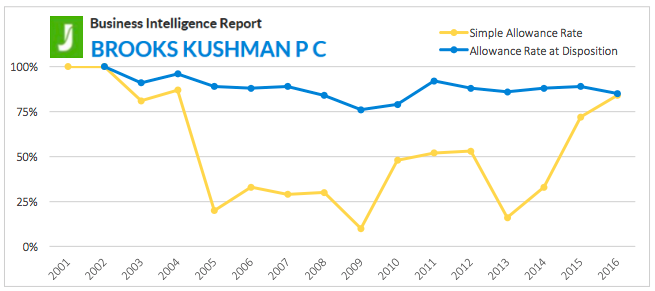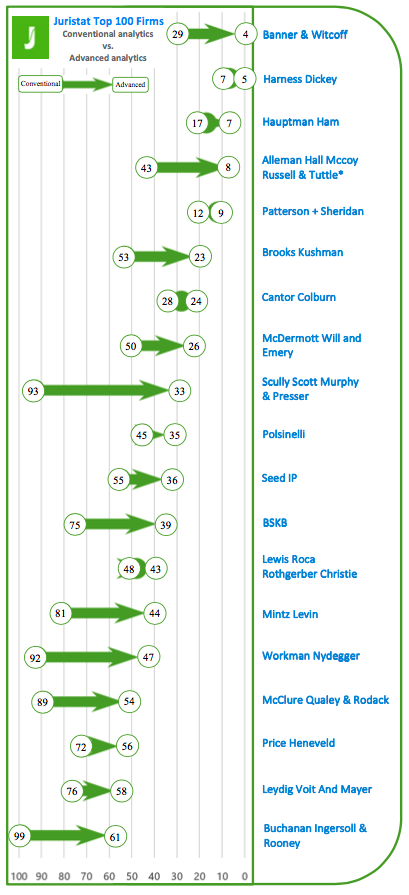Editor’s Note: Although this article references certain companies and law firms, they are intended to be only representative examples. This article, and the data herein, is provided independent of the entities referenced herein.
Advanced Analytics – Strategic Solutions Require Nuanced Data
Patent professionals are keenly aware that basic analytics can significantly improve their practices. These simple data points, such as allowance rates and office action rates, offer tactical insights and help patent professionals prosecute an application as efficiently as possible. As firms and practitioners become increasingly aware that simple analytics can increase allowance rates, reduce overhead, and increase margins, the demand for more advanced and nuanced analytics has increased substantially.
Advanced analytics include metrics such as complex allowance rates, average response time metrics, and extension rates, and allow patent professionals a clearer picture of the patent prosecution process. These analytics inform targeted strategic insights for approaching an application, and allow busy practitioners to allocate resources more effectively throughout the prosecution process. Advanced analytics more accurately demonstrate how firms and practitioners add value at each stage of the prosecution process, providing essential information for inventors and assignees looking for representation, and for firms marketing to clients.
Allowance Rates – (Mis)Defining Success
Juristat’s first business analytics product that provided the allowance rate of firms and assignees and was revolutionary when we released it in 2014. We provided the first objective metric to let patent professionals know how they stacked up against their competitors and to orient and focus their marketing efforts. Since that time, simple firm- and assignee-level allowance rates have become a regular fixture in the patent analytics landscape but, as our recent research shows, looking only to these simple metrics can be misleading, if viewed in isolation.
Simple allowance rate analytics are simple measures: the number of applications allowed divided by the sum of allowed and abandoned applications (allowed/(allowed+abandoned)). This formula generally works well to describe a firm’s performance but can significantly underreport the true allowance rate. Many firms’ clients change the attorney of record after allowance, often to in-house personnel or a lower-cost firm that is charged with maintaining the patent. These maintenance entities replace the actual prosecuting entity in the patent record, artificially lowering the prosecuting entity’s overall allowance rate.
How Much Simple Allowance Rates Miss

We looked at one firm, Brooks Kushman PC, and its application history since 2000. Brooks Kushman is a high-volume firm whose clients include large corporate patent holders and, as such, we would expect them to show a robust allowance rate and application volume. However, because Juristat tracks patent data, such as the firm of record, at multiple points throughout the prosecution, Juristat knows that many assignees often reassign granted patents to maintenance entities after prosecution is completed. This can result in firms that perform significant work for assignees with such practices, such as Brooks Kushman, not getting credit for the work they have done when looking only at a simple allowance rate.
Looking just at Brooks Kushman’s Ford Motor Company profile, for example, we found a 16 percentage-point difference between Brooks Kushman’s simple allowance rate, a slightly below average 71%, and its actual allowance rate, a highly effective 87%. Simple allowance rates also missed over 40% of Brooks Kushman’s work on behalf of Ford, showing 2,139 applications while the firm had in fact prosecuted 3,619. Even more striking is the 13-year gap between the simple and at-disposition allowance rates for Brooks Kushman’s work on behalf of Ford, testament to the potential inadequacies of simple allowance rates.
 Allowance rates: Brooks Kushman as firm, Ford Motor Company as assignee
Allowance rates: Brooks Kushman as firm, Ford Motor Company as assignee
From this it is clear to us that simple allowance rates, while not fundamentally flawed, are often too simple a measure, and that patent professionals need a more nuanced way to assess performance and value. Because of this, Juristat’s Business Intelligence contains features to provide just such nuanced information.
Advanced Allowance Rates – Allowance Rates at Disposition
Patent prosecutors know that their value is often measured by their efficiency and effectiveness. Juristat is the only company that provides the true measure of that effectiveness by looking at allowance rates at multiple stages, including at the time of disposition. Our analytics more accurately reflect value by giving credit where it is due – to the patent prosecutors who won the allowance.
 *Alleman Hall Mccoy Russell & Tuttle has since split into two firms
*Alleman Hall Mccoy Russell & Tuttle has since split into two firms
Understanding a firm’s allowance rate at disposition provides a much more accurate marker of value than conventional analytics. Firms already know that using our Business Intelligence analytics allows them to better market themselves. In-house counsels know that they can use Business Intelligence to find the right prosecution team for their patent portfolios. Our advanced analytics help ensure that patent prosecutors don’t get undervalued
Who is Undervalued?
We looked at our most recent Juristat Top 100 report that used simple allowance rates and compared it against the list of those same firms using our allowance at disposition metric. Below is the list of firms that would jump in ranking, and just how much they would rise. Ask Juristat what your true value is.
Put Advanced Analytics to Work
Juristat’s advanced analytics allow patent professionals to be better at what they do: maximizing the value of intellectual property by making informed decisions at every step of the patent process. Our advanced analytics give you the most accurate, up to date, and nuanced information, information that can help you get a leg up on the competition or that can help you put a foot down with an examiner or client.
For a demonstration of what Juristat can offer you, click below or get in touch with us.
(gradient).webp)
